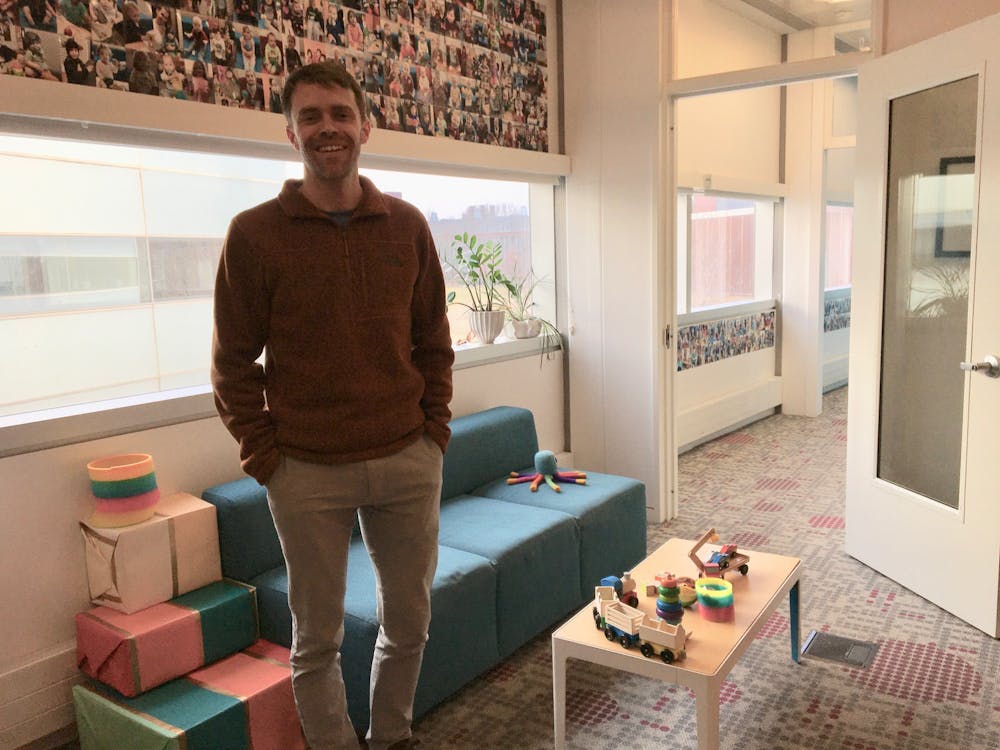Ever wondered what’s going on inside a baby’s head? The developmental psychology lab — better and more pleasantly known as the Baby Lab — might have an answer for you. The lab strives to increase scholarly knowledge about how babies learn to see, talk, and understand the world.
“We are interested in understanding how we learn at the beginning of life and why early learning is so consequential,” said Associate Professor of Psychology Casey Lew-Williams. Lew-Williams co-directs the Lab with Assistant Professor Lauren Emberson.
No developmental period proves more critical to success and well-being than the newborn years. The brains of babies and toddlers absorb the entire meaning of their environments — language, social interaction, visual information — without even the ability to speak.
“Before they can talk to us,” said postdoctoral fellow Dr. Elise Piazza, “babies’ brains are showing fairly sophisticated representations of the social world. They’re engaging with adults in communication in a way we can now start to measure with these new neuroimaging techniques.”
Piazza is responsible for one of the Baby Lab’s most significant recent accomplishments: the first study of how baby and adult brains interact during play. Piazza spent months measuring the brain activity in babies and their adult caregivers as the two played together.
Even as early as one year into life, found Piazza, babies’ brains showed a heightened activity when interacting with adults as opposed to during alone time. She found as well that — strikingly and heartwarmingly — during face-to-face communication, the adult’s and baby’s brain displayed synchronized wavelengths in the same regions.
Put simply: when adults play with babies, the two brains establish a connection.
Piazza’s research required her to monitor brain activity. And when it came to that, she and her colleagues encountered an issue. Neural synchrony is typically measured through magnetic resonance imaging (MRI) testing that requires the subject to lie still in a scanner for prolonged periods of time. Those restrictions made MRI technology impractical — if not impossible — for squirmy subjects.

That’s where Piazza’s aforementioned innovative neuroimaging techniques came in. She made use of another testing system, functional near-infrared spectroscopy (fNIRS), where a subject wears a cap with wires to image brain activity. With a grant from the Schmidt Fund, Piazza and her colleagues were able to design these caps for various head sizes. In theory, that made them perfect for babies.
Reality proved more nuanced; more than half of the infants either refused to wear the cap or took it off completely. But less fussy babies and their adult playmates both wore the fNIRS caps, allowing the team to measure coupled changes in brain activity across both parties.
“By using some contemporary methods for data collection, we're actually able to get quite a bit of information from babies even though their skill set is very limited,” Lew-Williams said. “They can look, they can listen, they can turn their heads, move their eyes, and we can capitalize on those very simple behaviors to learn a lot about cognition and sociality in our species.”
Over 1,000 families visit the lab each year. Many encourage their friends to visit, too, according to Lew-Williams. The Lab has worked diligently to make their “Baby Tiger” logo known through community events, such as advertising at pre-schools, in hospitals, at festivals, and even on social media.

The researchers relish the opportunity to study the brain at its most crucial stages of development, and the babies seem to have a fun time too. The waiting room of the lab is filled with books for all ages, a colorful carpet, and toys to play with before starting the experiment. Each child is able to stay with their parents the entire time and is given a slew of thank-you gifts at the end: a Baby Lab t-shirt or a book, and, as a gift for Mom or Dad, a reusable water bottle or a canvas bag, as well as financial reimbursement for travel expenses.
A day in the lab doesn’t only help scientists understand more about human interactions and how our brains develop and learn. It provides them as well with the joyful privilege of interacting with Princeton’s littlest tigers.
“It is very rewarding to work with kids,” Piazza said. “They kind of wear their hearts on their sleeve and to get to see them light up and just have a blast during play or singing with the experimenter … it kind of gives you this instant gratification that you don't get from adults.”








